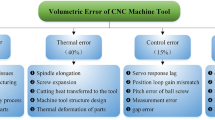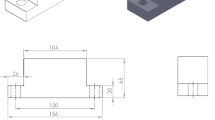Abstract
Predicting the quality of a machined component is the grandiose signification in manufacturing industry. Calculation of the cutting force is one of the most important elements to predict the quality of machined parts. In this paper, a linear force model is developed in which the cutter’s helix angle is incorporated to calculate the cutting force coefficients for the milling process. On the effect of cutter’s helix angle, all derivations of cutting forces are directly based on the tangential, radial, and axial cutting force components. In the developed mathematical model, with the stable milling condition, the average cutting forces are expressed as a linear function of the feedrate, and the cutting force coefficient model is formulated by a function of average cutting force and cutter geometry such as cutter diameter, number of flutes, cutter’s helix angle. An experimental method is proposed based on the stable milling condition to estimate the cutting force coefficients. This method can be applied to each pair of cutter and workpiece. The developed cutting force calculation model has been successfully verified by both simulation and experiment with very promising results. Integrated application with a virtual three-axis milling machining simulation system has also been implemented to demonstrate potential utilization of this developed model.
Similar content being viewed by others
References
Merchant ME (1945) Mechanics of the Metal Cutting Process. I. Orthogonal Cutting and a Type 2 Chip. J Appl Phys 16:267. doi:10.1063/1.1707586
Altintas Y (2012) Manufacturing automation: metal cutting mechanics, machine tool vibrations, and CNC design, 2nd edn. Cambridge University Press, New York, ISBN 978-1-00148-0
Fernández-Abia AI, Barreiro J, López de Lacalle LN, Martínez-Pellitero S (2012) Behavior of austenitic stainless steels at high speed turning using specific force coefficients. Int J Adv Manuf Technol 62:505–515
Guibert N, Paris H, Rech J (2008) A numerical simulator to predict the dynamical behavior of the self-vibratory drilling head. Int J Mach Tools Manuf 48:644–655
Budak E, Altintas Y, Armarego EJA (1996) Prediction of milling force coefficients from orthogonal cutting data. ASME J Manuf Sci Eng 118:216–224
Sonawane HA, Joshi SS (2010) Analytical modeling of chip geometry and cutting forces in helical ball end milling of superalloy Inconel 718. CIRP J Manuf Sci Technol 3:204–217
Li XP, Li HZ (2004) Theoretical modelling of cutting forces in helical end milling with cutter runout. Int J Mech Sci 46:1399–1414
Yang M, Park H (1991) The prediction of cutting force in ball-end milling. Int J Mach Tools Manuf 31:45–54
Lee P, Altintas Y (1996) Prediction of ball-end milling forces from orthogonal cutting data. Int J Mach Tools Manuf 36:1059–1072
Budak E, Ozturk E, Tunc LT (2009) Modeling and simulation of 5-axis milling processes. CIRP Ann Manuf Technol 58(1):347–350
Cheng PJ, Tsay JT, Lin SC (1997) A study on instantaneous cutting force coefficients in face milling. Int J Mach Tools Manuf 37:1393–1408
Bayoumi AE, Yucesan G, Kendall LA (1994) An analytic mechanistic cutting force model for milling operations: a theory and methodology. Trans ASME J Eng Ind 116:324–330
Shin YC, Waters AJ (1997) A new procedure to determine instantaneous cutting force coefficients for machining force prediction. Int J Mach Tools Manuf 37:1337–1351
Larue A, Anselmetti B (2003) Deviation of a machined surface in flank milling. Int J Mach Tools Manuf 43:129–138
Azeem A, Feng HY, Wang L (2004) Simplified and efficient calibration of a mechanistic cutting force model for ball-end milling. Int J Mach Tools Manuf 44:291–298
Ko JH, Cho DW (2005) Determination of cutting-condition-independent coefficients and runout parameters in ball-end milling. Int J Adv Manuf Technol 26:1211–1221
Subrahmanyam KVR, San WY, Soon HG, Sheng H (2010) Cutting force prediction for ball nose milling of inclined surface. Int J Adv Manuf Technol 48:23–32
Altintas Y (2000) Modeling approaches and software for predicting the performance of milling operations at MAL-UBC. Int J Mach Sci Technol 4(3):445–478
Budak E (2006) Analytical models for high performance milling. Part I: cutting forces, structural deformations and tolerance integrity. Int J Mach Tools Manuf 46:1478–1488
Adetoro OB, Wen PH (2010) Prediction of mechanistic cutting force coefficients using ALE formulation. Int J Adv Manuf Technol 46:79–90
Wang M, Gao L, Zheng Y (2014) An examination of the fundamental mechanics of cutting force coefficients. Int J Mach Tools Manuf 78:1–7
Compeán FI, Olvera D, Campa FJ, López de Lacalle LN, Elías-Zúñiga A, Rodríguez CA (2012) Characterization and stability analysis of a multi variable milling tool by the enhanced multistage homotopy perturbation method. Int J Mach Tools Manuf 57:27–33
Wan M, Zhang WH, Qin GH, Tan G (2007) Efficient calibration of instantaneous cutting force coefficients and runout parameters for general end mills. Int J Mach Tools Manuf 47:1767–1776
Wan M, Lu MS, Zhang WH, Yang Y (2012) A new ternary-mechanism model for the prediction of cutting forces in flat end milling. Int J Mach Tools Manuf 57:34–45
Dang JW, Zhang WZ, Yang Y, Wan M (2010) Cutting force modeling for flat end milling including bottom edge cutting effect. Int J Mach Tools Manuf 50:986–997
Wan M, Zhang WH, Dang JW, Yang Y (2010) A novel cutting force modeling method for cylindrical end mill. Appl Math Model 34:823–836
Bhattacharyya A, Schueller JK, Mann BP, Ziegrt JC, Schmitz TL, Taylor FJ, Fitz-Coy NG (2010) A closed form mechanistic cutting force model for helical peripheral milling of ductile metallic alloys. Int J Mach Tools Manuf 50:538–551
Perez H, Diez E, Marquez JJ, Vizan A (2013) An enhanced method for cutting force estimation in peripheral milling. Int J Adv Manuf Technol 69:1731–1741
Wang B, Hao H, Wang M, Hou J, Feng Y (2013) Identification of instantaneous cutting force coefficients using surface error. Int J Adv Manuf Technol 68:701–709
Liu XW, Cheng K, Webb D, Luo XC (2002) Improved dynamic cutting force model in peripheral milling. Part I: theoretical model and simulation. Int J Adv Manuf Technol 20:631–638
Narita H (2013) A determination method of cutting coefficients in ball end milling forces model. Int J Autom Technol 7(1):39–44
Tukora B, Szalay T (2011) Real-time determination of cutting force coefficients without cutting geometry restriction. Int J Mach Tools Manuf 51:871–879
Gao G, Wu B, Zhang D, Luo M (2013) Mechanistic identification of cutting force coefficients in bull-nose milling process. Chin J Aeronaut 26(3):823–830
Gradišek J, Kalveram M, Weinert K (2004) Mechanistic identification of specific force coefficients for a general end mill. Int J Mach Tools Manuf 44:401–414
Author information
Authors and Affiliations
Corresponding author
Rights and permissions
About this article
Cite this article
Kao, YC., Nguyen, NT., Chen, MS. et al. A prediction method of cutting force coefficients with helix angle of flat-end cutter and its application in a virtual three-axis milling simulation system. Int J Adv Manuf Technol 77, 1793–1809 (2015). https://doi.org/10.1007/s00170-014-6550-8
Received:
Accepted:
Published:
Issue Date:
DOI: https://doi.org/10.1007/s00170-014-6550-8




